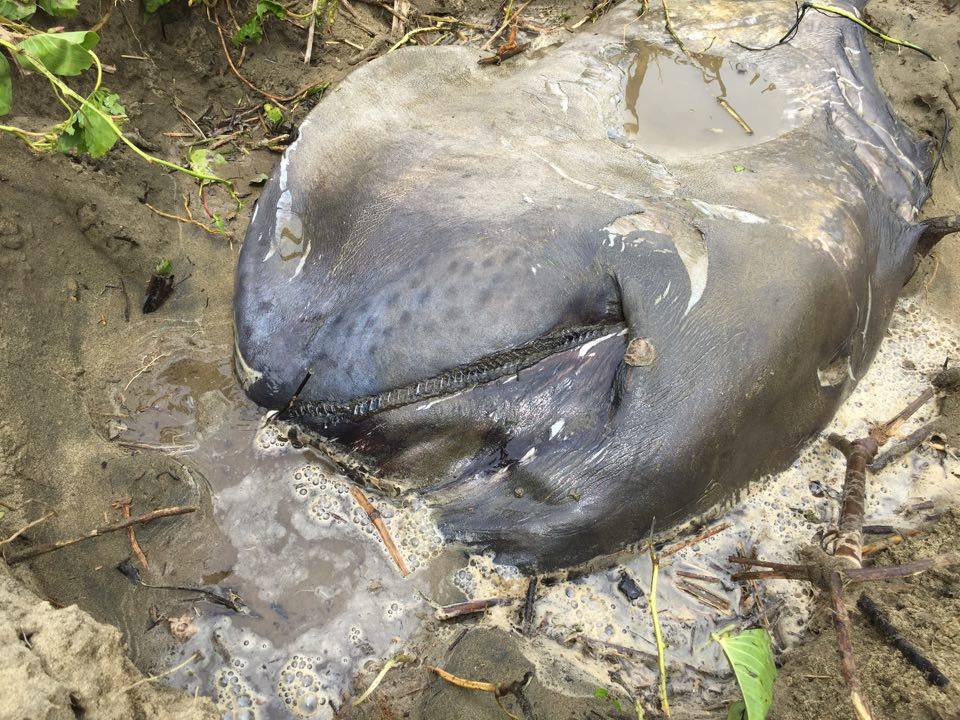
The head of the rare megamouth shark which died due to fishnet entanglement in Bayawan City, Negros Oriental dug out for necropsy by marine scientists of the Large Marine Vertebrates Research Institute Philippines.
DUMAGUETE CITY – A rare juvenile megamouth shark (Scientific name: Megachasma pelagios) measuring some four meters died after it was accidentally caught in a fishing gear in Bayawan City, Negros Oriental over the weekend.
It is believed to be the first megamouth shark stranding in the Philippines this year and the second in Bayawan City, with the first sometime in 2006, marine scientists say.
An initial report from the Bureau of Fisheries and Aquatic Resources (BFAR) in Bayawan City, headed by Faith Napigkit, said that at around 6 a.m. Sunday, a Bantay Dagat team received information that a megamouth shark was accidentally caught in the drift net of Dionisio Chiu, a fisherman.
Chiu was fishing approximately 10 nautical miles from the shoreline, with Sicopong River in nearby Sta. Catalina town as a reference point, when the megamouth shark got entangled, the report said.
The dead shark was towed towards the coastline of Barangay Villareal, Bayawan City.
The shark was measured at 4.34 meters in body length, the BFAR said.
Upon learning of the incident, marine scientists Dr. Alessandro Ponzo, executive director of the Large Marine Vertebrates Research Institute Philippines (LAMAVE), and AA Yaptinchay, director of Marine Wildlife Watch Philippines, who were in Apo Island in Dauin, Negros Oriental on Sunday, wanted to immediately conduct a necropsy of the rare megamouth shark for scientific research.
However, they learned it was already buried in the shoreline of Sitio Sampaguita, Barangay Villareal Sunday afternoon, but the Bayawan City local government vowed to exhume it the following day so they could get tissue samples and check on the dead shark.
On Monday, a team from LAMAVE proceeded to Bayawan City and coordinated with authorities to dig the shark out, said Ponzo.
Only half of its body was dug out and the team took measurements, genetic samples, and a sample for the National Museum, he further said.
Dr. Ponzo confirmed it was a juvenile, male megamouth shark and appeared to have died after it was caught in the net of the fisherman.
Very little is known of the megamouth shark and thus scientists are taking every opportunity to study it, according to Dr. Alessandro Ponzo, executive director of the Large Marine Vertebrates Research Institute Philippines (LAMAVE).
“This is the 118th specimen globally and the 20th for the Philippines,” he said.
According to Dr. Ponzo, the megamouth shark lives in deep water and feeds on planktons, like the manta ray and the whale shark.
In the Philippines, Bohol Sea has “one of the highest record number in the world after Japan and Taiwan” for megamouth sharks sightings, he disclosed.
Initial findings point to the megamouth’s cause of death as fishing gear entanglement because it could no longer breathe, said Ponzo.
LAMAVE is interested in doing a necropsy and study of the megamouth shark “because it is really rare and the Bohol Sea can really be an important hotspot worldwide for this animal,” he added.
“But you only see it when its dead, and is rare to encounter it alive because it lives very deep (in the sea),” the marine scientist explained.
“It is important to know more of the biology and ecology of this animal and the best way is by doing a necropsy and collect samples,” Dr. Ponzo pointed out.
With the samples, Dr. Ponzo hopes that they can do “a genetic study of the megamouth shark and see how they are connected to the population in Taiwan, and those that live in the Bohol Sea or Sulu-Sulawesi Sea, or part of the whole Pacific (Ocean) population.”
The megamouth is one of the three filter sharks species in the world, the other two, namely, the basking shark and the whale shark, he said.
Humans have rare encounters with the megamouth shark because there are very few of them in the world and do not come close to shore, Ponzo explained.
There may be only five or six live encounters with megamouth sharks in the world, he added. (PNA)
